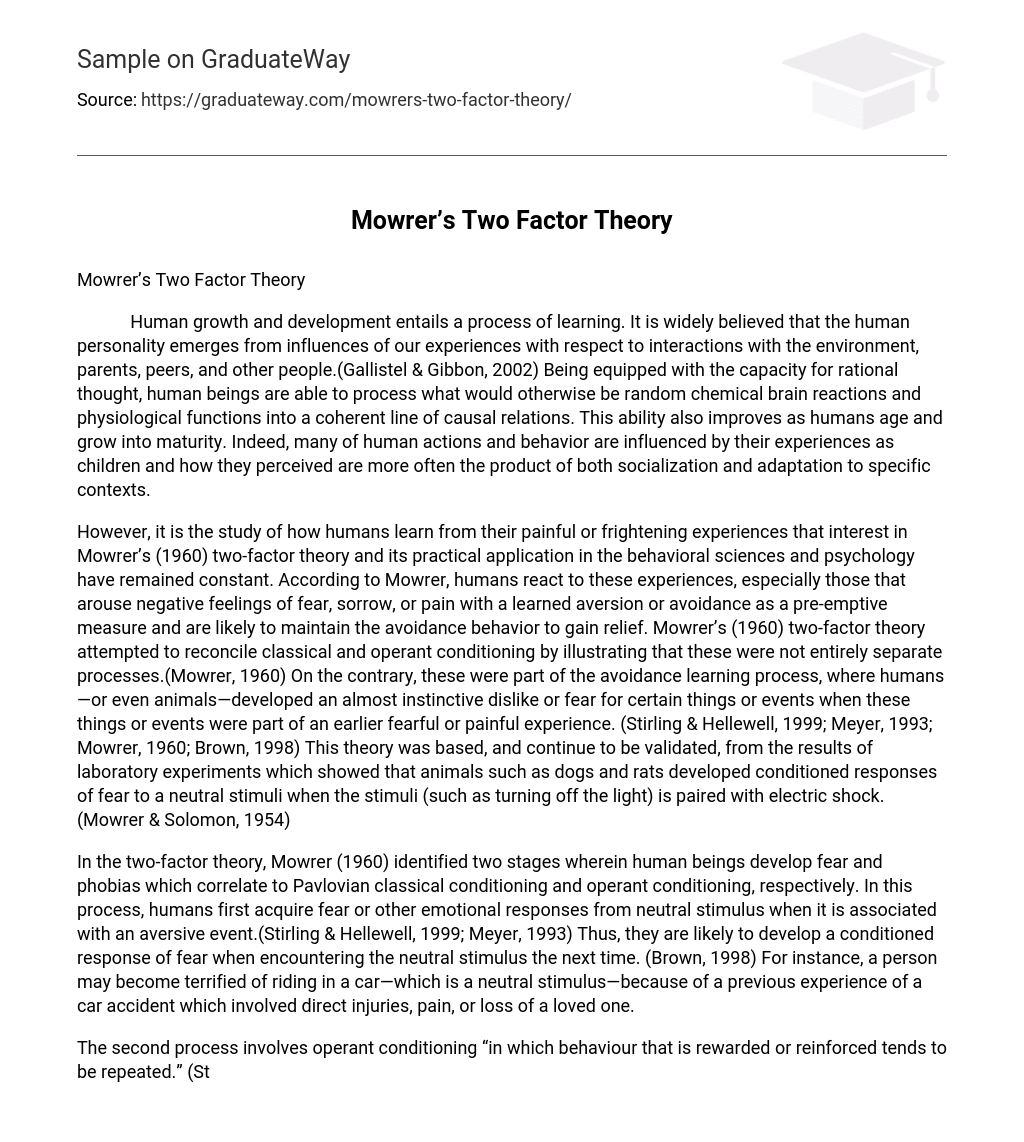Human growth and development entails a process of learning. It is widely believed that the human personality emerges from influences of our experiences with respect to interactions with the environment, parents, peers, and other people.(Gallistel & Gibbon, 2002) Being equipped with the capacity for rational thought, human beings are able to process what would otherwise be random chemical brain reactions and physiological functions into a coherent line of causal relations. This ability also improves as humans age and grow into maturity. Indeed, many of human actions and behavior are influenced by their experiences as children and how they perceived are more often the product of both socialization and adaptation to specific contexts.
However, it is the study of how humans learn from their painful or frightening experiences that interest in Mowrer’s (1960) two-factor theory and its practical application in the behavioral sciences and psychology have remained constant. According to Mowrer, humans react to these experiences, especially those that arouse negative feelings of fear, sorrow, or pain with a learned aversion or avoidance as a pre-emptive measure and are likely to maintain the avoidance behavior to gain relief. Mowrer’s (1960) two-factor theory attempted to reconcile classical and operant conditioning by illustrating that these were not entirely separate processes.(Mowrer, 1960) On the contrary, these were part of the avoidance learning process, where humans—or even animals—developed an almost instinctive dislike or fear for certain things or events when these things or events were part of an earlier fearful or painful experience. (Stirling & Hellewell, 1999; Meyer, 1993; Mowrer, 1960; Brown, 1998) This theory was based, and continue to be validated, from the results of laboratory experiments which showed that animals such as dogs and rats developed conditioned responses of fear to a neutral stimuli when the stimuli (such as turning off the light) is paired with electric shock.(Mowrer & Solomon, 1954)
In the two-factor theory, Mowrer (1960) identified two stages wherein human beings develop fear and phobias which correlate to Pavlovian classical conditioning and operant conditioning, respectively. In this process, humans first acquire fear or other emotional responses from neutral stimulus when it is associated with an aversive event.(Stirling & Hellewell, 1999; Meyer, 1993) Thus, they are likely to develop a conditioned response of fear when encountering the neutral stimulus the next time. (Brown, 1998) For instance, a person may become terrified of riding in a car—which is a neutral stimulus—because of a previous experience of a car accident which involved direct injuries, pain, or loss of a loved one.
The second process involves operant conditioning “in which behaviour that is rewarded or reinforced tends to be repeated.” (Stirling & Hellewell, 1999) In this stage, “the appropriate motor response or behavior is learned, this learning being guided by the emotional responses learned in the first phase.” (Meyer, 1993)This stage is a continuation of the first process wherein humans may respond to remove their fear by avoiding the neutral stimuli that causes this fear. This results to a negative reinforcement wherein a person is likely to keep avoiding the stimulus because he or she is rewarded with comfort (or the absence of fear) by doing this. Consequently, the conditioning itself, or the repeated process of avoiding exposure to the feared stimuli becomes rewarding in itself.
Stirling & Hellewell (1999) notes that avoidance learning may lead to “the persistence and generalisation of the disorder” or a prolonged phobia since it deprives the person the opportunity to gain alternative experiences to counter the previous fearful experience. For instance, the person who keeps avoiding car rides because of his fear of a car accident will never get to experience a pleasant car ride “which might to extinction of the conditioned anxiety.” (Stirling & Hellewell, 1999)
Mowrer’s (1960) two factor theory is therefore very useful in arriving at an explanation on why we fear things based from our previous bad experiences with them. For instance, we fear examinations and school tests because of memories of having difficulty with them or failing them that might have been a source of embarrassment or anger from our parents. The examinations therefore becomes a stimuli with which we become conditioned to fear, and some people may go to the extent of avoiding taking exams because it takes away the dreadful feelings. In many cases, we refrain from doing things that may lead to disappointment. Sometimes we become afraid of being honest to people because we had experiences when our honesty was met with prejudice, or we become afraid of trusting people because of past experiences of being betrayed by those we consider our friends. Thus, we develop a tendency or the negative reinforcement to avoid entering into relationships to avoid getting betrayed and hurt and therefore derive some form of relief or reward from this behavior. When this pattern is repeated over and over again, we never learn that some people can be honest and trusted—although we might have to be very careful in choosing whom we trust—and lose the capability to overcome our fears.
Works Cited:
Brown, B. Mowrer’s two factor theory of phobias. 1998. downloaded from www.gpc.edu on 04/04/07 http://www.gpc.edu/~bbrown/psyc1501/disorders/mowrer.htm
Gallistel, C. R. & J. Gibbon.(2002) The Symbolic Foundations of Conditioned Behavior. Mahwah: N.J. Lawrence Erlbaum Associates, Inc.
Meyer, J. (1993). From Animals to Animats 2: Proceedings of the Second International Conference of Simulation of Adaptive Behavior. Cambridge: MIT Press.
Mowrer, O.H. (1960) Learning Theory and Behavior. Wiley.
Mowrer, O.H. & L.N. Solomon. (1954). Contiguity vs. drive-reduction in conditioned fear: The proximity and abruptness of drive-reduction. The American Journal of Psychology, 67(1): 15-25.
Stirling, J. & J.S.E. Hellewell. (1999). Psychopathology. New York: Routledge.





